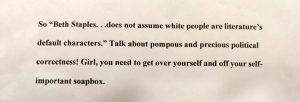I read Beth Staples’ Editor’s Note to the new issue of Shenandoah aloud, in the car, from my phone. Chris and I were on our way to a poetry reading by Sara Robinson, Patsy Asuncion, and others at Ragged Branch Distillery–a gorgeous setting–while sun and clouds chased each other across the mountains. We had read an earlier draft of Beth’s essay, which was prompted by a piece of hate mail:

She nailed the revision, we agreed, and then argued about which was the funniest line in the piece. “From a person with questionable taste in fonts,” Chris insisted. No, it’s her rewrite of the opening of Pride and Prejudice, I countered. In any case, Beth’s remarks are important, reflecting questions I often think about while reading submissions AND reading for fun. In much contemporary fiction by white authors, nonwhite characters are typically described by race, while white characters get to be defined by other characteristics, like status or occupation or temperament–which makes me sputter with irritation when I want to be lounging with a paperback.
In verse, how a white author addresses, or sidesteps, whiteness comes through more clearly over a suite of pieces than in a single poem, mostly because a poem contains fewer words and less story than your average prose piece. A poem gives you select glimpses from which you intuit and imagine a landscape. Race, therefore, is sometimes a matter of hints and absences in the poems from this Shenandoah issue. I love them all, and I delight in the ways they refract different identities and experiences: 68.2 contains poetry about language, immigration, aging, abortion, artificial insemination, difficult parents, difficult children, difficult neighbors, food, friendship, nonhuman animals, love, anger, political treaties, sexual harassment, disability, music, apocalypse, and clowns. Race joins that heady mix, but mostly in poems by authors who are not white–and that’s something an editor, and an author, must think about.
Books of mine currently in the publication pipeline–especially a novel and my next poetry collection–DO concern whiteness. In early drafts of these works, I made mistakes, because my skill and thoughtfulness were inadequate. Many editors rejected many of those efforts–rightly, I now believe, although it was discouraging at the time. Writing about race in a contemporary or historical way, from the perspective of a white person who hasn’t always been required to pay attention to it, was/ is risky, and I’m not sure the products are thoroughly successful–I’m worried there are failures in the books I can’t yet see, and really hoping, if so, that my editors will call me out–but in any case, I did learn some things and end up with at least some good writing. I decided I’d rather fail by trying than by silence.
So I especially appreciate Beth’s Editor’s Note. If you find it provocative and/ or useful, also check out the “Gutting the Chicken” feature, about a flash fiction piece by Stephen Graham Jones that was initially rejected. The editors focused on gender questions the piece raised and missed some things about race, and I would say the author did something similar but in reverse, although all parties are brilliant and careful (I think Jones’ work is amazing). The intro, flash fiction, and accompanying interview would be a great suite to teach, raising some pretty interesting editorial and writerly conundrums.
But every piece in the issue is worth reading! I’m particularly excited about the novel excerpt (and eager for Joukhadar’s book–he’ll give a reading here in February). Don’t miss the special features at the bottom of the page, either, which are full of their own insights and challenges. I’m happy, heading into summer, that there’s so much cool stuff to read, even (or especially?) when it makes me uncomfortable–as long as the author doesn’t address me as “girl.”



One response to “A view from the masthead”
[…] Lesley Wheeler, A view from the masthead […]
LikeLike